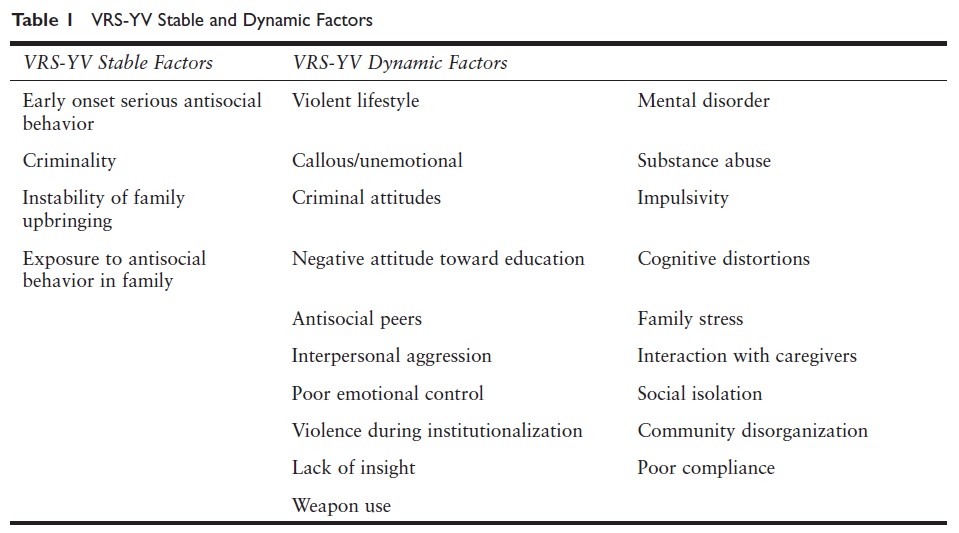It is important to assess risk of future violence for adolescents who have been charged with or convicted of criminal offenses, especially when these offenses are of a serious and/or violent nature. However, assessment of violence risk in and of itself is insufficient. Risk reduction and the prevention of future violence should always be viewed as the ultimate goal of violence risk assessment. As such, tools that can bridge the link between violence risk assessment and violence reduction treatment can be beneficial to service delivery providers. The Violence Risk Scale–Youth Version (VRS-YV) is arguably one such assessment tool. This article provides an overview of the VRS-YV as well as research on its effectiveness.
Overview of the VRS-YV
The VRS-YV is part of a family of risk assessment and treatment planning tools developed by Stephen Wong and colleagues. These include the Violence Risk Scale (VRS) and Violence Risk Scale–Sex Offender Version (VRS-SO). Both the VRS and VRS-SO have been adapted for use with youth, with the VRS-YV being the youth version of the adult VRS.
The VRS-YV is a 23-item clinician-rated measure designed to assess adolescents’ risk of violent offending and inform interventions intended to reduce violence risk. Consistent with the adult version of the tool, the VRS-YV includes both historical or stable risk factors and dynamic or potentially changeable risk factors associated with future violence as shown in Table 1.

The four stable and 19 dynamic factors are rated on a 4-point scale (from 0 to 3) using broad descriptions of the constructs measured by each item included in the manual. Higher ratings indicate stronger associations between the item and future violent and/or aggressive behavior. Ratings for each item are then added together to provide static and dynamic totals and an overall score.
The VRS-YV dynamic items can also be used to identify targets for intervention and measure therapeutic change. Dynamic items rated highly (i.e., items scored as a 2 or 3) are conceptualized as problem areas requiring treatment and therefore are considered treatment targets. Each treatment target is rated pre- and posttreatment using a modified version of James Prochaska’s 1992 stages of change model. The original model was used to capture efforts to change health-related behaviors. For instance, when attempting to quit smoking, people usually move along a behavioral continuum whereby they first deny they have a problem (pre-contemplation) to accepting that they might (contemplation), to preparing to making positive changes (preparation), to consistently making such changes over a substantive period of time (action), and then to maintaining such gains in the face of high-risk situations (maintenance). Using this modified stages of change model, numerical values are assigned to these stages of change and the amount of change observed on each treatment target can be assessed at Time 1, reassessed at Time 2, and quantified. Such a mechanism provides a structured way to adjust risk to account for changes made over time, with development, and during the course of treatment.
Research on the VRS-YV
Preliminary research on a diverse sample of 147 Canadian young offenders referred for assessment and treatment services at a local community mental health facility suggests the VRS-YV performs similarly to other established youth forensic risk tools. For instance, the VRS-YV could be rated consistently and reliably, and VRS-YV static, dynamic, and total scores significantly predicted general and violent recidivism with moderate to high accuracy. Additional analyses further suggested that VRS-YV items tended to hang together in three main groups, or factors: interpersonal aggression, antisocial tendencies, and family problems. These factors may reflect constructs underpinning violence risk and could be used to assist case formulation and treatment planning efforts. Treatment planning may also be informed by examining the pattern of VRS-YV scores which form a dynamic risk profile (i.e., an individual fingerprint of sorts, which visually illustrates the hills and valleys of relative treatment targets and areas of strength for an individual youth).
Research examining the capacity of the VRSYV to assess change merits further exploration, especially in light of positive findings obtained in research evaluating adult counterparts (i.e., VRS, VRS-SO).
Final Thoughts
Preliminary research supports the use of the VRSYV with youth who may be referred for specialized assessment and treatment services (e.g., serious and violent young offenders). While additional research employing larger samples of more treated youth is clearly required, the VRS-YV is a promising tool that would seem to merit further investigation.
References:
- Stockdale, K. C., Olver, M. E., & Wong, S. C. P. (2014). The validity and reliability of the violence risk scale– youth version in a diverse sample of violent young offenders. Criminal Justice and Behavior, 41, 114–138.
